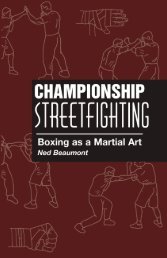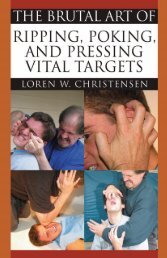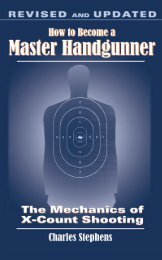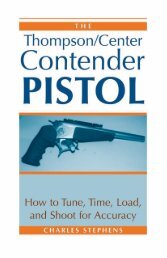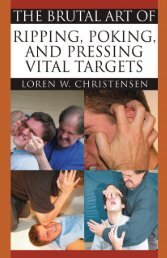The Dueling Sword
The Dueling Sword
The Dueling Sword
- No tags were found...
You also want an ePaper? Increase the reach of your titles
YUMPU automatically turns print PDFs into web optimized ePapers that Google loves.
THEDUELINGSWORDBYCLAUDE LA MARCHEIllustrationsBY MARIUS ROYTranslated byBRIAN HOUSEPALADIN PRESS • BOULDER, COLORADO
TABLE OF CONTENTSPagesChapter I—THE FOIL AND THE ÉPÉE 1Chapter II—ÉPÉE EQUIPMENT 11Choice of the Blade 12<strong>The</strong> Bell Guard 17<strong>The</strong> Grip 20<strong>The</strong> Pommel 22<strong>The</strong> Glove 23<strong>The</strong> Shoes 24Chapter III—THE LESSON 29Holding the Épée 30<strong>The</strong> Position 37<strong>The</strong> Guard 38<strong>The</strong> Advance 57<strong>The</strong> Attacks 59<strong>The</strong> Attack Lesson 62Five rounds on the engaged bladePress 63Absence of Blade 64Beat 66Froissement 67Cut Over 69Four rounds with the blade not engagedPress 73
xxviii<strong>The</strong> <strong>Dueling</strong> <strong>Sword</strong>Cut Over 74Threat 75Froissement 75<strong>The</strong> Parries 82Feeling for the Periphery 84Considerations on the Parries 86Opposition Parries 89Opposition and Counter Opposition Parry Combinations 90Opposition Parry Combinations 90Double Counter Opposition Parries 91<strong>The</strong> Ripostes 93Tac au Tac Riposte 93Ripostes by Disengagement 95Ripostes by Cut Over 97Attacks While the Opponent Retreats 100Chapter IV—APPLICATION OF THE LESSON 113Attacks 114Opponent Does Not Move 114Opponent Retreats 124Opponent Retreats Out of Bounds 128Corps–a–Corps 132Parries and Ripostes 140Parries 141Ripostes 157Counter Ripostes 162<strong>The</strong> Stop Thrusts and Tempos 165Épée Thrusts 187
Table of ContentsxxixChapter V—THE BOUT 195<strong>The</strong> Desired Thrusts 223A Few Words on the Bout 230§ 1. On the Subject of the Left-Handed 230§ 2. <strong>The</strong> Question of Height 235§ 3. <strong>The</strong> Silence Under the Weapons 239Chapter VI—OBSERVATIONS ON THE DUEL 243§ 1. Incorrect Thrusts 243§ 2. Use of the Unarmed Hand 251§ 3. Disarmament 259§ 4. <strong>The</strong> Witnesses 261Chapter VII—LESSON OF THE EVENING BEFORE 267
THE ÉPÉE—CHAPTER ITHE FOIL AND THE ÉPÉEIn all of the studies onfencing, one chapter is devotedto l’école du terrain, au jeude l’épée. 1It is toward the end of the book.This chapter is indispensable. It drawsthe attention of the reader, who is alreadytired, and this chapter is usuallyvery short. <strong>The</strong> author describes the results of his particular experience,and since the recommendations he gives are, most of thetime, excellent, without reproach we have to say that they havethe grave inconvenience of too generalized instructions.It seems when reading the annex of this book that knowl-1
2<strong>The</strong> <strong>Dueling</strong> <strong>Sword</strong>edge of the épée is a natural development from the corollary artof the foil.And yet nothing is further from the truth!We would have to consider as novel inventions or as a resultof mere chance the stories that show us an expert foil fencer defeatedin a duel by an opponent who does not have any fencingknowledge. If the practice of foil is a prerequisite to épée—andlet us say it loudly—essential to becoming a serious épée fencer,it should also be admitted that the handling of the épée is from aseparate science, with its own specific lessons, its particular training,and its distinct attitudes.In this regard there existed in the literature of fencing a voidthat we took upon ourselves in the first edition of this book tofill, at least to the best of our ability.Since the publication of our work in 1884, the bibliography ofépée has grown. Mr. Jacob published a volume on <strong>The</strong> Game of theÉpée. Mr. Cabot has offered an excellent volume on the game in thefield. Mr. Baudry has published the principles of his method in PracticalFencing, and finally, as of late we have the work of Mr. Spinnewyntitled Fencing with the Épée.Never before has the épée become so fashionable as nowadays.We have committed to the practical application of fencing,au jeu du terrain, 2 with extraordinary ardor. Never before haveso many épée blades been broken in the salles 3 ; the master almostbecame tired of mounting them. We have surpassed thelimit. We have put the épée in the hands of people who neverfenced foil; who do not know how to advance, to retreat, tolunge, to come on guard, to attack, to parry; who have never been
<strong>The</strong> Foil and the Épée 3exposed to any of the actions of delicacy, decision, and precisionthat constitute the grace, the strength, and the certitude of fencing.<strong>The</strong>y were taught, more or less, an advantageous position;they have learned a few thrusts that were mere novelties inwhich luck was always a big part and which have nothing to dowith the finesse and cunning of real fencing phrases, that givecharm and clarity of convention to a bout.<strong>The</strong>y were not made to wait. <strong>The</strong>y fenced very early on. <strong>The</strong>ydid what they could, the master applauded: everyone was happy.<strong>The</strong>y pretend that the study of the foil is not required inorder to make an épée fencer, leaving little or nothing at all toluck. This is the old game. A humoristic writer, editor of a recentpaper on the épée, even claimed, not without some disdain, thatfoilists are those who persist in believing in the indispensableutility of the foil in order to acquire a light hand, a supple calf, afast and strong body that can withstand punishment as well as aserene hand and clear vision, that can conceive quickly and beobeyed immediately.<strong>The</strong>y can say what they want; it is only the foil that can teachus the orthography of fencing. To think otherwise is to not knowthe foil. To know and to judge the foil, one has to have used it fora long time, having been patient, having been tenacious, havingbent often under fatigue, having felt more than once discouragementfrom the difficulty of directing that small blade, of protectingone’s self and of carrying the button to the target that onehas resolved to thrust.Usually, only the chest is thrust, but we all know that we canalso thrust the head and the advanced targets on the day that therules for foil are replaced by the necessity of combat. In reality, ittakes a lot of time and courage to make a foilist. I would prefer
4<strong>The</strong> <strong>Dueling</strong> <strong>Sword</strong>not to ascertain how many fencing masters exempt their studentsof all toil and patience by allowing them to fence épée immediately,less concerned about helping them by teaching thanattracting and keeping them at the salle.It is useless to argue.We have said and we repeat it: foil fencing is the best and onlyschool, the perfect preparation, indispensable to the regular, certain,and brilliant practice of the épée. <strong>The</strong>re is no doubt about it.In a few lessons, a skillful fencer, if he is well gifted, can becomea dangerous man with an épée in his hand.We said “if he is well gifted,” and this condition is a prerequisite,for the épée game is above all a matter of the head.<strong>The</strong> fencing lesson with the foil gives the student the precisionand quickness of the eye, the speed of the hand, the vigor ofthe calf, the length of breadth.It teaches him to search, to discover, to surprise, and to reachthe theoretical space that the plastron 4 covers and which iscalled the chest, the flank, and the belly. Outside these areas thethrust does not count; it is, as it is said, off target.A foil bout is a great battle, with the use of conventions in attackas well as in riposte 5 to thrust the middle of the body.Anything else is the tactic of the épée with its feints, its skirmishesaround the advance targets, whatever they may be, thehand, the head, or the thighs.Here everything counts, and the art consists in thrusting theopponent in the chosen target, all the while avoiding beingthrust in the principal and secondary parts of one’s own body. Ifit were sufficient to end the fight, at all cost, while thrusting any
<strong>The</strong> Foil and the Épée 5part of the opponent’s body, the épée game, with use of a lot ofcaution and a little bit of decisiveness, would be a relatively easymatter in many instances.But we trust that he who holds an épée in hand must be ableto proportion the wound that he wants to inflict to the insult hehas endured, and if we consider as a great misfortune the deathof a man as a result of a futile quarrel, 6 we must also considerthat it is regrettable for a man of honor to see reparation byblood stopped by an insignificant thrust, thrusting the fingers orthe hand of the one who has insulted him.However, only the long and patient practice of the foil givesthe hand the firmness and the assurance that allows the well-directedpoint to evade and deceive the opposing blade and thenthrust the target that the head has chosen.<strong>The</strong> well-directed thrust is the ideal, and the goal of the art offencing; a surprising thrust at the end of a phrase of arms, it is theexecution of an idea, the element of a plan.<strong>The</strong> conception, the execution, the speed, and a sense of theappropriate are exactly what are missing from those who are ignorantof fencing. <strong>The</strong> day a fencing master has the courage to affirmand put into practice this truth, he will not have a singlestudent left. That is why one is silent and accepts things as theyare. Primo vivere! 7We have followed with close attention the instructions givenby reputed fencing masters with good reason. We were astounded
6<strong>The</strong> <strong>Dueling</strong> <strong>Sword</strong>by the way they gave la leçon de terrain, 8 which consisted of excessivelycautious advice being given to their students.Today we no longer talk about a man whose notoriety has alwaysbeen a surprise to us: Jules Jacob.At a time when the épée was neglected in the fencingsalles, he was the only one to profess it. This gentle individualhas inflicted upon the art of fencing a deplorable influence,which at that time was not discussed.On the day that the masters and fencers tackled the art of theépée, Mr. Jacob’s method ceased to exist.Albeit he defended in his book the accusation that he wasnot a partisan or a supporter of serious thrusts, but we know otherwise,by having seen that everything in his lesson leads approximatelyto one single goal: wounding the hand.We opine that in an épée bout, the hand of the opponentmust without doubt be perpetually worried. <strong>The</strong> goal of this tacticis to minimize—above all—the deep attacks that the opponentmight be tempted to execute, and also to lead him to believe thatthe goal is to thrust his wrist, or to receive a counterattack fromhim to one’s own forearm as an acceptable way of ending theduel. Finally, we might have the intention, by feigning an attack tothe hand, to make a strong beat and to go deep to his body.With these conditions, one can see, the enormous variety ofgood thrusts renders the attacks more dangerous and the defensemore difficult.



